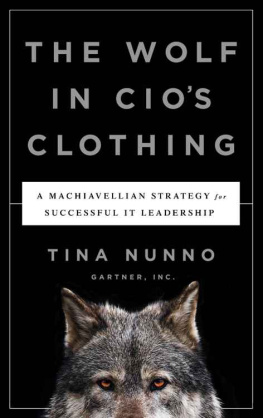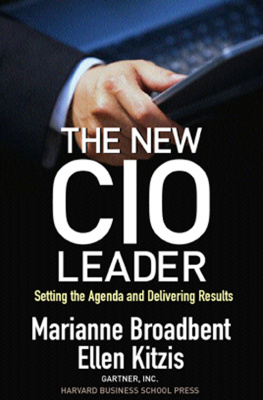
Additional Books by Gartner Authors
Learn more at gartner.com/books
Gamify: How Gamification Motivates People to Do
Extraordinary Things
Brian Burke
Bibliomotion, Inc., 2014
The Digital Edge:
Exploiting Information and Technology for
Business Advantage
Mark P. McDonald and Andy Rowsell-Jones
Gartner, Inc., 2012, eBook
The Social Organization:
How to Use Social Media to Tap the Collective Genius
of Your Customers and Employees
Anthony J. Bradley and Mark P. McDonald
Harvard Business Review Press, 2011
The CIO Edge:
Seven Leadership Skills You Need to Drive Results
Graham Waller (Gartner), George Hallenbeck
(Korn/Ferry) and Karen Rubenstrunk (Korn/Ferry)
Harvard Business Review Press, 2010
The Real Business of IT:
How CIOs Create and Communicate Value
Richard Hunter (Gartner) and George Westerman,
(MIT)
Harvard Business Press, 2009
Mastering the Hype Cycle: How to Choose
the Right Innovation at the Right Time
Jackie Fenn and Mark Raskino
Harvard Business Press, 2008
Are you a Wolf CIO?

As you read this book, consider your own approach to the three Machiavellian disciplines: Power, Manipulation and Warfare. Are you more comfortable on the light or dark side?
Take the Wolf CIO quiz and find out.
www.gartner.com/wolfcio.
First Bibliomotion edition
(previously published by Gartner, Inc.)
Bibliomotion, Inc.
39 Harvard Street
Brookline, MA 02445
Tel: 617-934-2427
www.bibliomotion.com
Copyright 2015 by Gartner, Inc.
All rights reserved. No part of this publication may be reproduced in any manner whatsoever without written permission from the publisher, except in the case of brief quotations embodied in critical articles or reviews.
Library of Congress Cataloging-in-Publication Data
Nunno, Tina.
The wolf in CIOs clothing : a Machiavellian strategy for successful IT leadership / Tina Nunno. First Edition.
pages cm
Summary: In The Wolf in CIOs Clothing, Gartner analyst and author Tina Nunno expands on Machiavellis metaphor, examining seven animal types and the leadership attributes of each Provided by publisher.
ISBN 978-1-62956-087-8 (hardback) ISBN 978-1-62956-088-5 (ebook)
1. Information technologyManagement. 2. Leadership. I. Title.
HD30.2.N86 2015
004.068'4dc23
2014047443
Dedication
This book is dedicated to my husband Frank. Throughout my travels many people have wondered aloud about what kind of a man would be married to a woman like me. Fortunately for me, the answer is an amazing man who has a great sense of humor, which he needs to deal with me, and who is always supportive of my endeavors, no matter how absurd they are. Without you, this book would not have been possible.
Contents
As a leader, do you think of yourself as predator or prey? Are you a wolf or a lamb? In other words, which animal best describes your leadership style? Are you a fighter, a protector, or a formidable ally? Most importantly, what do you stand for and believe in as a person and as a leader? Are you willing to fight for what you believe in, and can you protect the things you value?
These may seem like unusual questions to ask the CIOs, future CIOs, and IT leaders for whom I wrote this book. Your CEOs, CFOs, and colleagues likely dont ask such things of you and probably dont think of you in this way. They are more likely to think of you as a service provider. And they often expect service providers to do what they are told, when they are told to do it, no matter how unreasonable or absurd the request may be.
At the same time, many CEOs and boards of directors recognize the transformational role of technology. They have seen its power to radically change business models and provide extraordinary competitive advantage. They want to use technology creatively and strategically to achieve that competitive advantage and claim to want IT leaders who will break out of the service mold, lead much more aggressively, and work with them to shape a new digital future.
So why isnt it happening? Lets look at the data. In the year since this book was released, more than 4,500 IT executives have taken the Wolf Quiz to learn their Extreme Animal Profile. You can take it at www.gartner.com/wolfquiz, and I encourage you to do so before you read this book. In a recent discussion with a client, I told him that approximately 47 percent of the survey participants exhibited some Wolf-like tendencies. He asked, So why havent we made more progress?
Here is why. CIOs with Wolf leadership tendencies are often told those tendencies are wrong and that they should get back into the service provider box. Unfortunately, many of them comply. Their senior executives and business colleagues, who claim to want IT leaders, miss the service providers who did what they were told. Or, they feel threatened by the new predator on the block rather than welcoming her into the pack.
Neither CIOs nor CEOs understand the real leadership dynamics, which need to change in order for CIOs to succeed and for their enterprises to use technology to win. In order for both of these positive results to occur, CIOs and their colleagues must recognize a few simple realities.
First, predators only partner with other predators. Predators dont partner with prey. Service providers are prey. Predators eat prey. They play with prey. They do not partner with them.
I have spoken with some non-IT executives who have stated, My CIO is not a leader; he just does what he is told. These executives are pointing out the uncomfortable reality that when we do what others tell us to do, we are rendered invisible. Leaders are not invisible or endlessly malleable, they have a presence all their own.
Second, IT leaders are reluctant to embrace the predator role. Predators are scary; therefore, they must be bad, right? Wrong. Just because you are scary does not mean you are the bad guy. But in tough times, if you are scary, I want you on my side.
I spoke with a female CIO recently who told me, I am not a Wolf! She then proceeded to tell me how she recently had dealt with a business colleague who had sent a disparaging e-mail about one of her staff. She marched to his office and explained in no uncertain terms why he would never speak to one of her team members in that manner again. Only after he apologized and promised to behave more appropriately, did she address his IT issue.
I looked at her and said, You are so Wolfy you have no idea! She was fiercely protective of her team, and had both the power and ability to draw the line so that she could actually protect them. Very Wolfy indeed.
It is important to note that the reverse corollary about scariness is also untrue. Just because you are nice does not mean that you are the good guy or gal. Consider another recent conversation I had with a nice IT executive (you could call him a Dolphin, which well get into in a few chapters) who loves his fast-growing company. His challenge was that the workload was so massive, the IT staff turned over on average every twelve to eighteen months. Their untenable workload was due to their inability to say no. They never refused an IT request. Ever. Why? We dont want to seem uncooperative or make them unhappy, he told me. I asked what he was doing about it and his response was, Im hiring more IT people. This is not the right answer.
Next page












